The Charles Archive: Church Towers
- 24th July 2018
This is the seventh in a series of blog posts celebrating the life and work of timber-frame building specialists FWB ‘Freddie’ and Mary Charles. Funded by Historic England, the ‘Charles Archive’ project aims to digitise and make more accessible the Charles Archive collection.
Inspired by material found within the Charles Archive this blog explores the timber-framed church towers and belfries that survive scattered around our county.
In all there are seven timber-framed towers, in Worcestershire, five of which are traditional black and white frames of varying forms, whereas the other two are internally framed belfries (Moriss and Brown 2000).
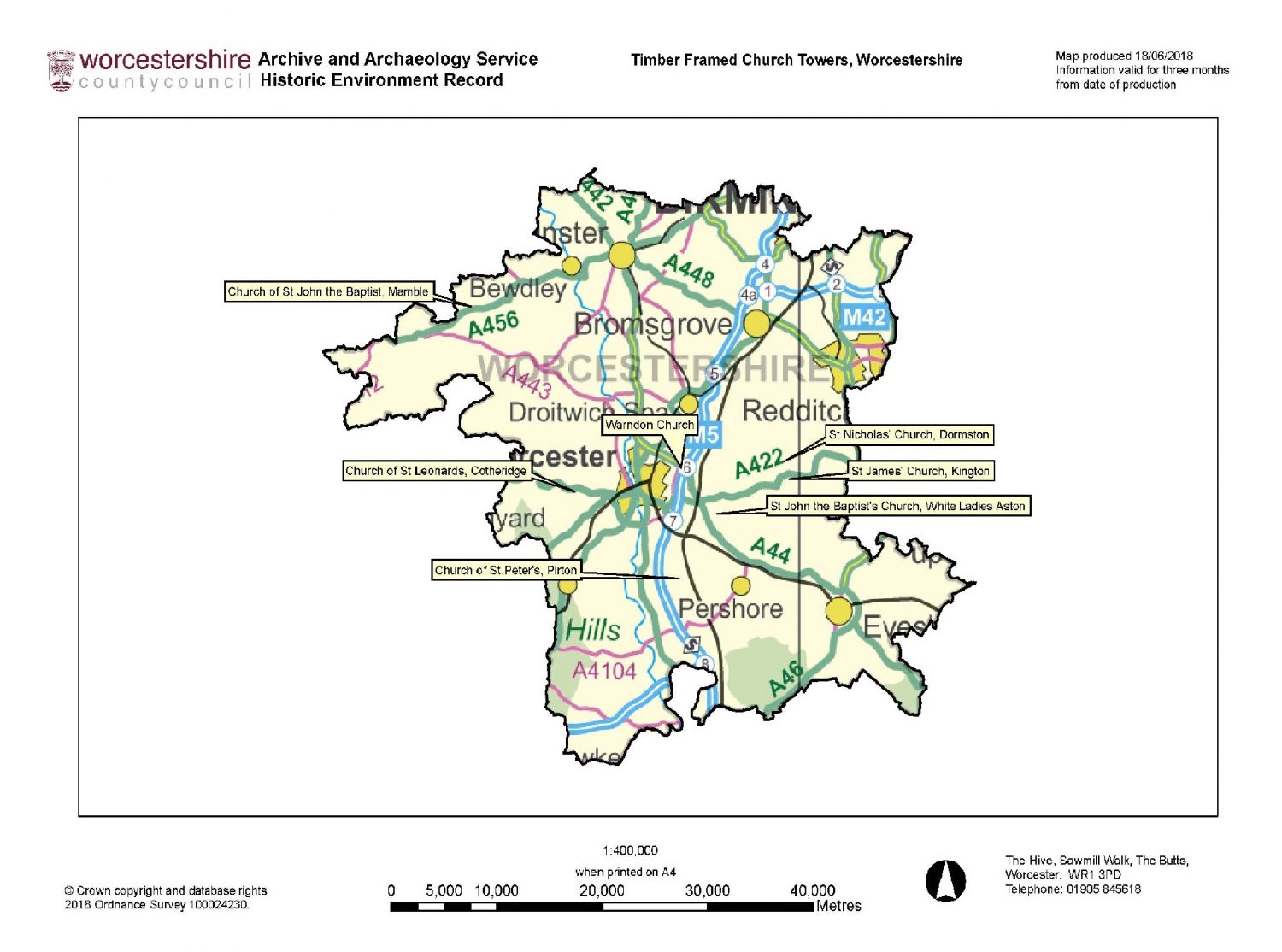
St. Nicholas, Dormston
The use of timber within this grade I listed 14th century church is extensive, which isn’t too surprising when you consider its location was once part of Feckenham Forest. The timber tower attached to the west end of the nave is 15th century and sits on a stone base with close studded black and white timber framing on the outside with a saddleback roof. The timber frame inside the tower has massive timber braces, some of which are quite crudely worked and finished (Pevsner 2007), (Worcesteranddudleyhistoricchurches.org.uk, 2018), (www.british-history.ac.uk, 2018), (Bridges, 2005). In 2011, the church received funding to make the urgent repairs needed to maintain and restore the timber frame of the tower and other parts of the church which had been damaged by decay and damp (Hlf.org.uk, 2018). However, this church is still on the Heritage at Risk Register for Historic England as other areas of the church are now effected by damp (Historic England, 2018). The Charles Archive includes original hand drawn elevation drawings of this tower completed in November 1988.
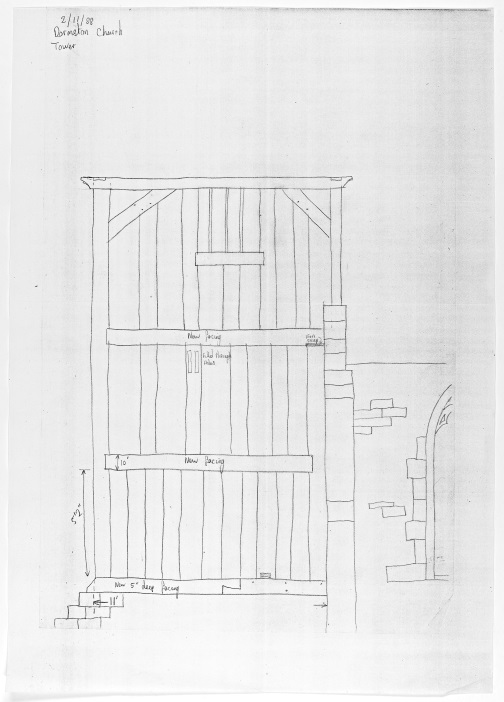
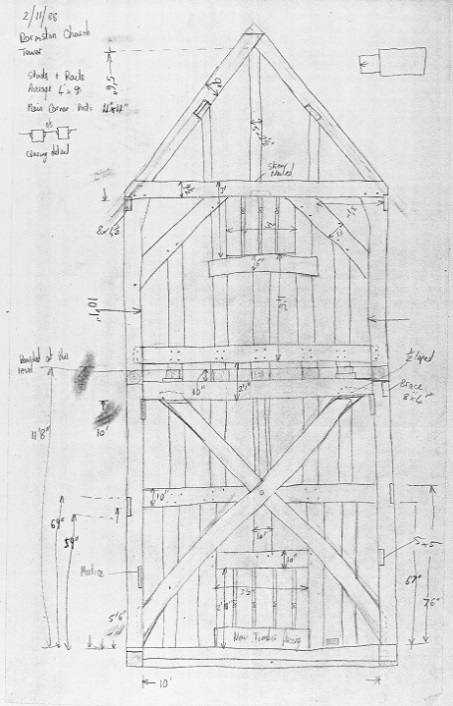
Digitised elevation drawings of Dormston Church Tower 1988. © Worcestershire Archive and Archaeology Service: Charles Archive Collection.
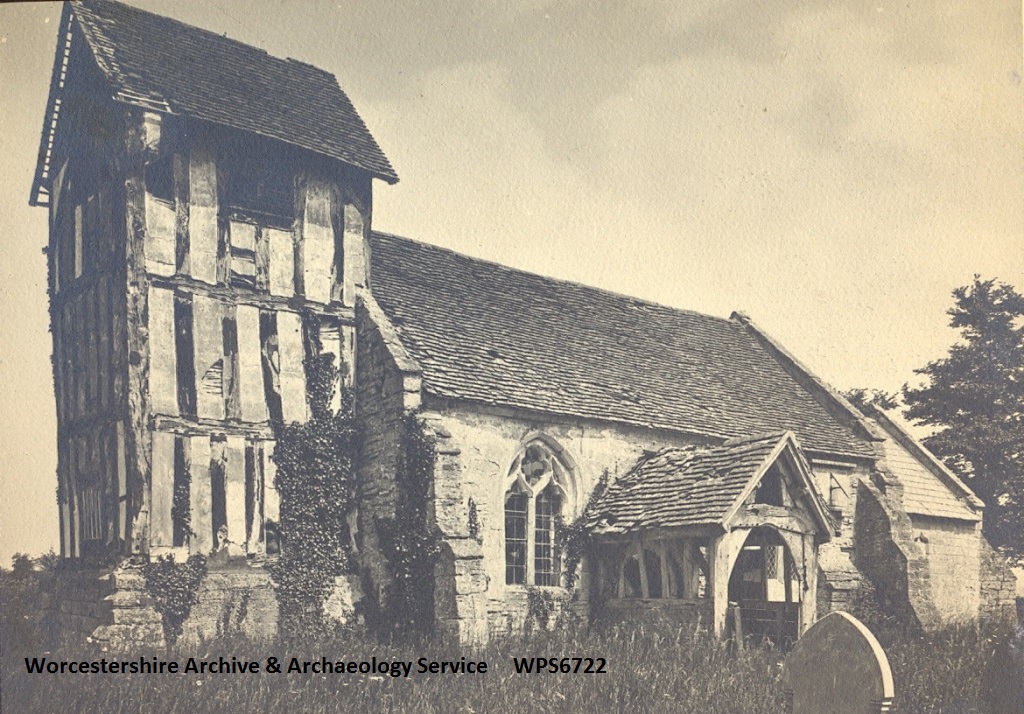
St. Leonard’s, Cotheridge
This grade II* listed church is to the west of Worcester and is dated to the 12th century with a timber framed tower added in the 14th or 15th century to the south of the nave. It is constructed of heavy pieces of chestnut and oak which are roughly hewn and set over four levels or stages. The first two stages are coated with plaster externally with the upper stages covered with weatherboarding, which are probably 18th century, which is then topped by a pyramidal roof (Worcesteranddudleyhistoricchurches.org.uk, 2018), (www.british-history.ac.uk, 2018), (Bridges, 2005). The church roof collapsed in 1947 and was repaired in 1961, however, a survey carried out in 1979 concluded that the church and tower were in need of urgent repair, which was completed in 1987 (Anon, 2011). The Charles Archive holds elevation drawings of the internal and external structure of the tower completed in August 1971 by Richard Abbott who worked for Freddy Charles’ architect firm during that period.
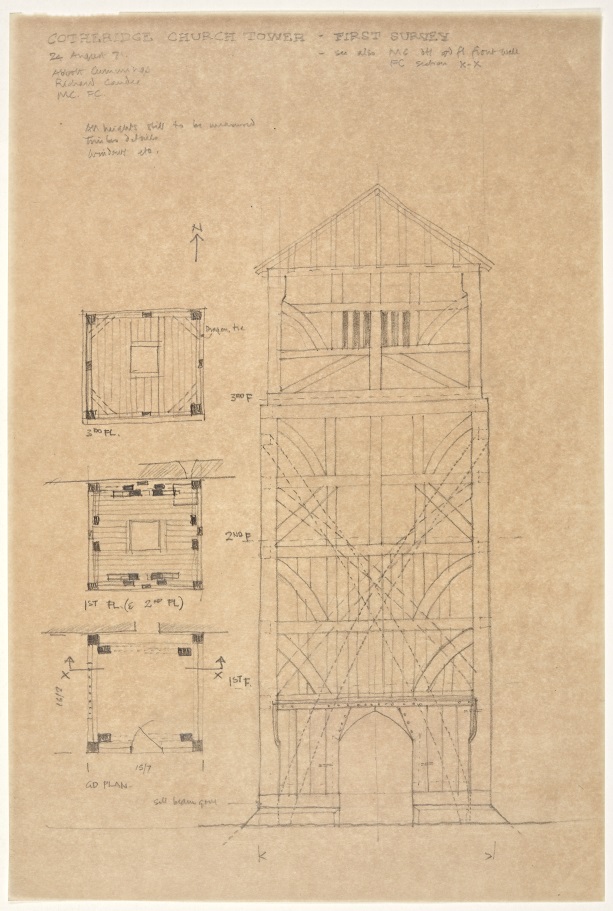
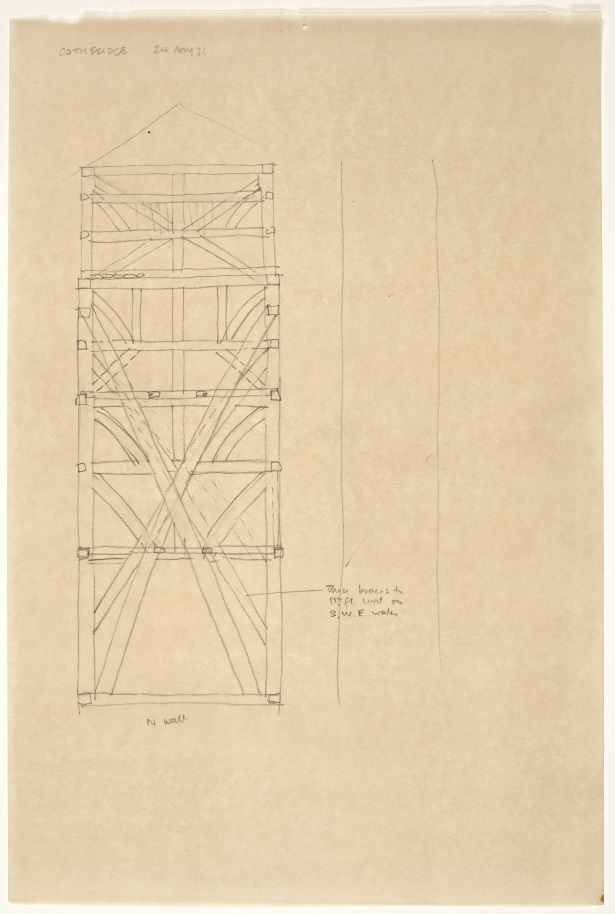
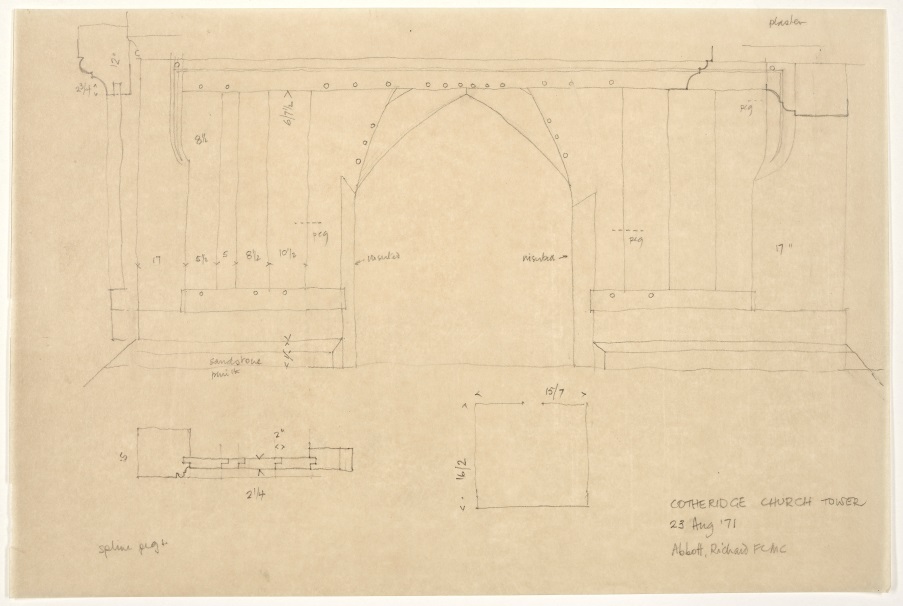
Digitised elevation drawings of St. Leonard, Cotheridge by Richard Abbott 1971 © Worcestershire Archive and Archaeology Service: Charles Archive Collection.
St. Nicholas, Warndon
There has been a church at this site since the pre-1200’s, which is set on the eastern edge of Warndon housing estate adjacent to the 17th century, grade II* listed Warndon Court and converted farm buildings. The distinctive black and white timber-framed tower that remains dates from the late 15th to the early 16th century, it replaced an earlier wooden belfry when the church was re-roofed. It is thought its simple construction and relatively late design were a cheaper alternative to a masonry tower (Worcesteranddudleyhistoricchurches.org.uk, 2018), (Bridges, 2005), (Moriss and Brown 2000). Within the Charles Archive there are several slides of photographs he took of the grade I listed church and tower.
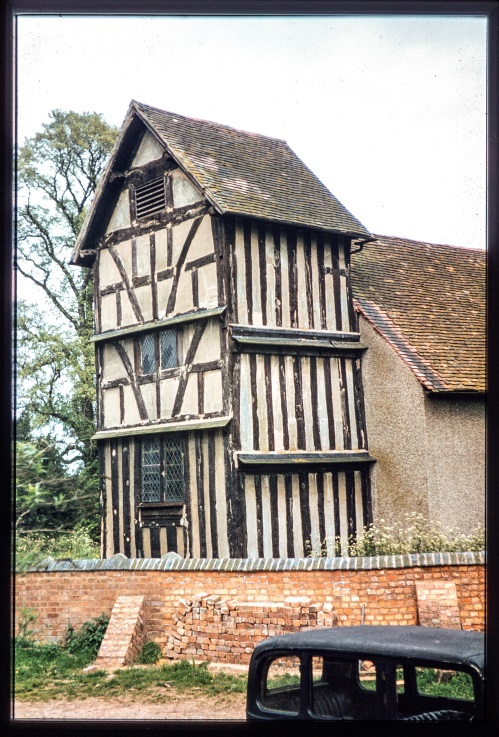
Digitised Slide of St. Nicholas Church, Warndon © Worcestershire Archive and Archaeology Service: Charles Archive Collection.
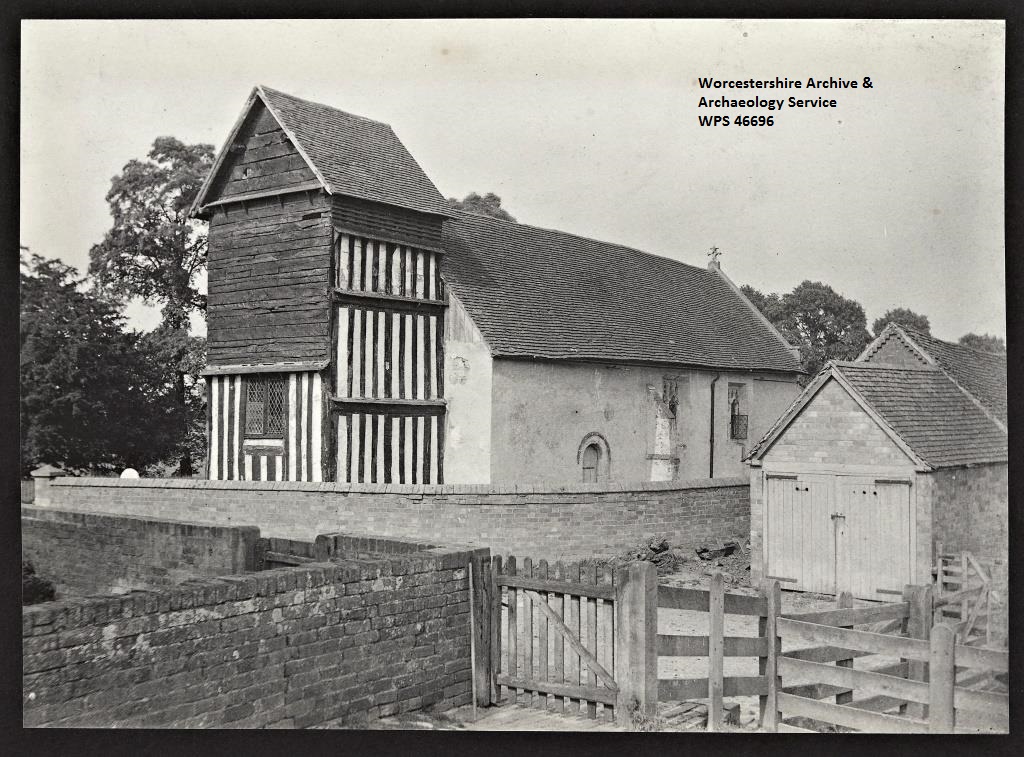
St. John the Baptist Church, Mamble
This grade I listed church dates from the 13th century and is set in the centre of the village. The west end of the nave is partitioned by a timber framed wall which conceals the massive timbers of the scissor framed bell tower. The lower part of the frame is original and an excellent example of medieval carpentry, which is verified through tree ring analysis to 1214 and 1255. The rest of the frame and belfry were added between 1582 and 1618 (Bridges, 2005), (www.british-history.ac.uk, 2018), (Sheffield University, 2005). It is thought this timber-frame structure was originally detached from the church, as it is built independently of the stonework of the surrounding nave walls (Bridges, 2005). The Charles Archive holds the original drawing of the bell frame from by John Wheatley who was an associate of Freddy Charles.
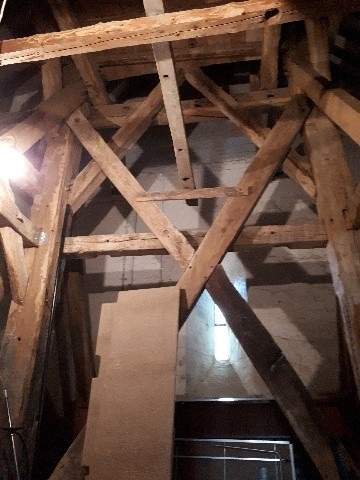
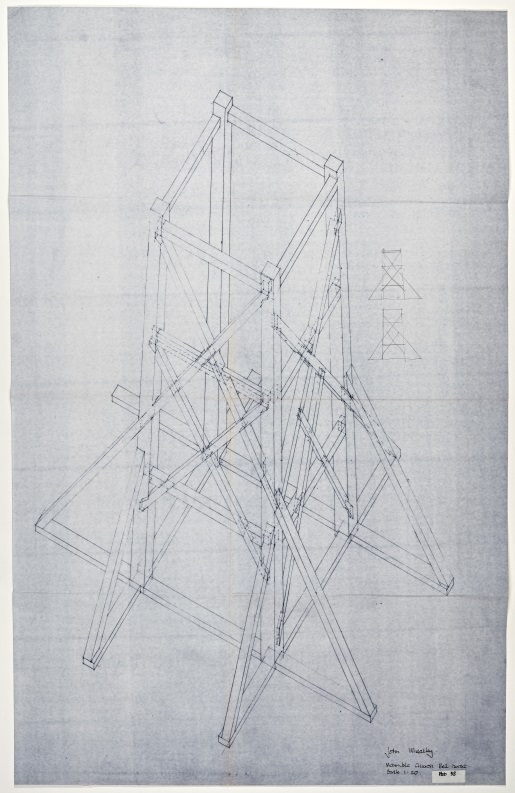
Interior view of Mamble Church Tower 2018 and digitised drawing of bell turret by John Wheatley 1988 © Worcestershire Archive and Archaeology Service: Charles Archive Collection.
St. James, Kington
The nave and chancel of this grade II* listed church dates to the 13th century. The timber-framed tower is on the west end of the nave and has large beams that sit on a stone base. There are two further levels or stages above this, all of which are close studded and topped with a saddleback roof. It is thought the frame dates from the 15th century, however, Freddie Charles suggests the frame may be contemporary with its 14th century stone base, as specific features in the framing, such as curved braces, are common features during this period (Bridges, 2005), (Pevsner, 2007).
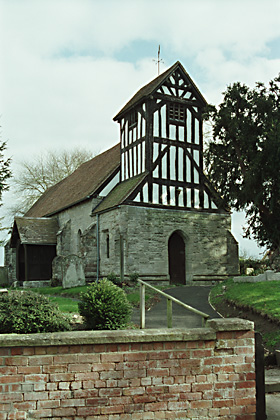
Exterior of St. James, Kington Images of England © Mr Peter Harnwell
Other timber framed church towers within Worcestershire:
St. John the Baptist Church, White Ladies Aston
This originally 12th century, grade II* listed church stands at the north end of the village, down an avenue of yew trees. The timber-framed tower is supported on large posts that stand in the church with the rest of the tower rising above the roof at the west end of the nave to form an octagonal spire. The earliest timbers from this frame are dated to the 15th century (Bridges, 2005), (www.british-history.ac.uk, 2018).
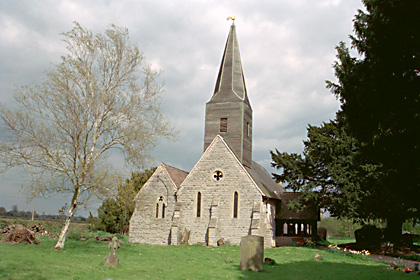
Exterior of St. John the Baptist, White Ladies Aston © Mr John Burrows DPAGB Images of England
St. Peter, Pirton
This 14th century church once included a central tower; however, it was taken down and replaced with a timber framed tower to the north of the nave in the 16th century. The exterior is made up of three bays with diagonal braces or crucks forming aisles that lean against the central tower. This type of support is not generally seen in this county, as it’s more common in Essex and Hertfordshire (Bridges, 2005), (www.british-history.ac.uk, 2018), (Pevsner, 2007). The interior timber-frame has scissor braces that are massive in size and structure, similar to the Mamble example. Tree ring analysis of the tower and bell frame was carried out in 2013 and reveal the majority of the timbers used were felled in 1507 with some reused timbers dating to the late 14th and 15th centuries (Arnold and Howard, 2013).
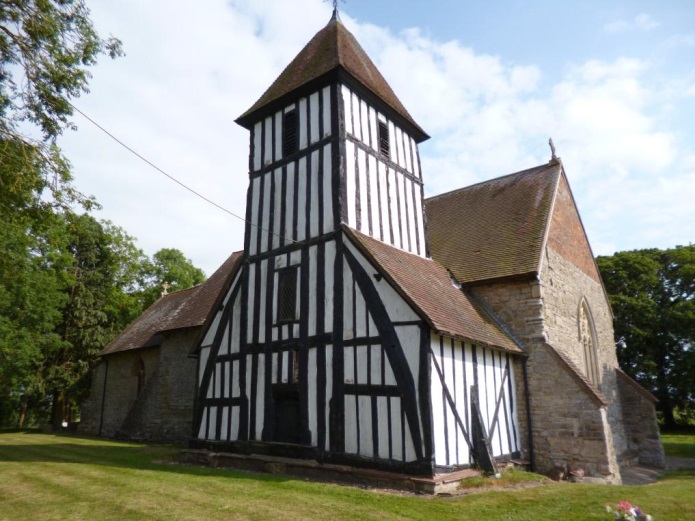
Exterior of church, Arnold and Howard, 2013
References and further reading:
Anon, 2011. Parish Church of St. Leonard, Cotheridge. Some notes on its history from circa 1125.
Arnold, A. and Howard, R. (2013). St Peter’s Church, Pirton, Worcestershire; Tree-ring analysis of samples from the timber-framed tower and bell frame. Nottingham: The Nottingham Tree Ring Dating Laboratory.
Bridges, T. 2000. Churches of Worcestershire. Logaston Press
Historic England, (2018). [online] Available at: https://historicengland.org.uk/advice/heritage-at-risk/search-register/list-entry/18718 [Accessed 29 Jun. 2018].
Hlf.org.uk. (2018). More than £1.57m for West Midlands historic places of worship | Heritage Lottery Fund. [online] Available at: https://www.hlf.org.uk/about-us/media-centre/press-releases/more-%C2%A3157m-west-midlands-historic-places-worship [Accessed 15 Jun. 2018].
Imagesofengland. (2018). English Heritage Images of England: a searchable photographic archive of historic buildings of England. [online] Available at: http://www.imagesofengland.org.uk/ [Accessed 29 June 2018]
Moriss, R. and Brown, D. (2000). Warndon Church, nr Worcester. Transactions of the Worcestershire Archaeological Society, 17(3), pp.197-201.
‘Parishes: Cotheridge’, in A History of the County of Worcester: Volume 4, ed. William Page and J W Willis-Bund (London, 1924), pp. 255-260. British History Onlinehttp://www.british-history.ac.uk/vch/worcs/vol4/pp255-260 [accessed 14 June 2018].
‘Parishes: Dormston’, in A History of the County of Worcester: Volume 4, ed. William Page and J W Willis-Bund (London, 1924), pp. 65-68. British History Onlinehttp://www.british-history.ac.uk/vch/worcs/vol4/pp65-68 [accessed 15 June 2018].
‘Parishes: Kington’, in A History of the County of Worcester: Volume 3 (London, 1913), pp. 191-193. British History Online http://www.british-history.ac.uk/vch/worcs/vol3/pp191-193 [accessed 14 June 2018].
‘Parishes: Mamble’, in A History of the County of Worcester: Volume 4, ed. William Page and J W Willis-Bund (London, 1924), pp. 285-289. British History Onlinehttp://www.british-history.ac.uk/vch/worcs/vol4/pp285-289 [accessed 14 June 2018].
‘Parishes: Pirton’, in A History of the County of Worcester: Volume 4, ed. William Page and J W Willis-Bund (London, 1924), pp. 180-184. British History Onlinehttp://www.british-history.ac.uk/vch/worcs/vol4/pp180-184 [accessed 15 June 2018].
‘Parishes: White Ladies Aston’, in A History of the County of Worcester: Volume 3 (London, 1913), pp. 557-561. British History Online http://www.british-history.ac.uk/vch/worcs/vol3/pp557-561 [accessed 14 June 2018].
Pevsner, N. and Alan, B. (2007). The Buildings of England. Harmondsworth: Penguin Books.
Sheffield University, 2005, Vernacular Architecture Dendrochronology Lists: Hereford and Worcester
Worcesteranddudleyhistoricchurches.org.uk. (2018). Worcestershire & Dudley Historic Churches Trust – Warndon. [online] Available at:
https://www.worcesteranddudleyhistoricchurches.org.uk/index.php?page=warndon [Accessed 14 Jun. 2018]
Post a Comment